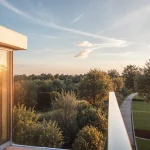Importance of Inclusive Green Spaces
Inclusive green spaces, such as urban parks, serve as essential community assets, fostering health and overall well-being. They provide a sanctuary that meets diverse needs and encourages physical activity, relaxation, and mental health. In bustling cities, these parks act as a natural refuge, offering urban dwellers a place to escape daily stresses and reconnect with nature.
Moreover, urban parks play a crucial role in promoting social cohesion. By welcoming individuals from all walks of life, they become melting pots of different cultures and backgrounds, facilitating interactions and understanding among citizens. This communal aspect of green spaces is particularly significant in promoting harmony and respect in diverse urban settings.
Also read : Expert bathroom fitters in sidcup for eco-friendly upgrades
Another key factor contributing to the significance of inclusive green spaces is their role in enhancing mental health. The presence of greenery has been shown to lower stress levels, decrease anxiety, and improve mood. By offering an environment rich with trees and plants, urban parks provide a natural remedy to the psychological pressures of city life. Through these benefits, inclusive green spaces stand out as indispensable components of vibrant, healthy communities.
Accessibility Considerations in Urban Planning
Creating truly inclusive green spaces requires thoughtful consideration of accessibility features. Ensuring that everyone can enjoy urban parks, regardless of physical ability, necessitates implementing universal design principles. Paths should be navigable for wheelchairs and strollers, while interactive installations should be approachable for individuals with sensory impairments.
In parallel : Transform your space with modern roof lanterns
Inclusive design principles emphasise features that accommodate diverse needs. For instance, providing clear navigational aids like tactile guidance systems supports visually impaired individuals. Meanwhile, ergonomic seating areas can benefit older adults or those requiring regular rest. These considerate provisions transform parks into enjoyable spaces for all visitors.
Best practices in planning urban park layouts involve actively engaging with stakeholders. This interaction ensures the needs of various demographics are addressed. For instance, input from disability advocacy groups can highlight essential enhancements previously overlooked, such as properly placed ramps or adjusted playground equipment.
A successful inclusive design not only elevates the functionality of a space but also fosters a welcoming environment for everyone. By embedding these features into the framework of urban planning, cities can ensure that green spaces remain assets for all community members, promoting equality and social integration.
Community Engagement in Green Space Development
Incorporating community involvement in green space development ensures that urban parks meet the unique needs of their residents. Participatory planning invites local voices to contribute ideas and feedback, leading to spaces that reflect community preferences and foster a sense of ownership. By encouraging stakeholder engagement, cities can design parks that are truly inclusive and resonate with diverse groups.
Understanding and gathering diverse perspectives is crucial for inclusive design. This approach captures the varied requirements of different demographics, whether they relate to cultural practices or specific accessibility needs. Engaging with local residents, community groups, and advocacy agencies results in more holistic and universally accepted park designs.
Numerous community-led green space projects showcase the benefits of combining local insight with professional expertise. For instance, when local communities are involved in designing park layouts or selecting plant species, the projects are more likely to succeed and gain widespread approval. Such initiatives ensure that parks not only serve recreational purposes but also form integral parts of community life, promoting sustainable interaction and enjoyment for all members.
Case Studies from Oxford and Similar Cities
Examining Oxford’s parks reveals impressive examples of how urban green initiatives can foster inclusivity. Notable parks, such as University Parks and South Park, are champions in accessibility and community engagement. These spaces effectively incorporate universal design, making them accessible to individuals of all abilities.
A comparative analysis with similar successful projects from other cities, like New York’s Central Park, highlights shared best practices. Both employ inclusive design principles, ensuring that paths, seating, and playgrounds accommodate a wide range of needs. This planning is crucial for encouraging social cohesion and providing environments where diverse groups can interact.
These case studies offer valuable lessons. Primarily, they illustrate the importance of involving local communities in the planning phase. Oxford’s parks have benefitted from stakeholder engagement strategies, which ensure that final designs meet real community needs.
Learning from these examples, cities can incorporate urban green initiatives that promote equitable access. By understanding the factors contributing to Oxford parks’ success, planners in other cities can adopt similar approaches, enhancing both the functionality and inclusivity of their urban green spaces.
Benefits of Green Spaces Beyond Aesthetics
While urban parks provide an oasis of natural beauty, their benefits extend well beyond aesthetic appeal. They significantly enhance urban biodiversity, supporting various plant and animal species. A well-planned green space acts as a vital ecological buffer, aiding in air purification, temperature regulation, and overall environmental health. This ecological impact fosters a balance within an urban ecosystem, proving essential for cities burdened by pollution and habitat loss.
The presence of green spaces in urban environments also brings about profound social benefits. These areas offer platforms for community events and gatherings, encouraging social interactions and fostering a sense of belonging among residents. Moreover, the economic impacts of green spaces should not be underestimated. By attracting tourism and increasing local property values, parks contribute to economic development.
Green spaces often serve as venues for recreational and cultural activities, promoting community engagement and cohesion. They provide opportunities for people to interact, work together, and build lasting relationships, which enhances social capital. By identifying and investing in the multifaceted value of inclusive green spaces, cities can create environments that support not just aesthetic pleasure, but also ecological sustainability and strong community ties.
Innovative Design Features for Inclusive Parks
Modern urban parks embrace design features that appeal to a wide array of visitors, creating spaces that are both functional and delightful. An exemplary feature is the sensory garden, which provides an inclusive environment where individuals engage with nature through touch, smell, and sight. These gardens enrich the experience for visitors of varying abilities, particularly those with sensory impairments.
Engaging landscapes further enhance accessibility. Thoughtfully designed landscapes, using natural materials such as stone and wood, offer varied textures and surfaces that are not only beautiful but also maintain ecological balance. Incorporating these materials ensures that park structures blend seamlessly with their surroundings, creating a welcoming atmosphere for everyone.
Beyond aesthetics, these features serve practical roles. For instance, interactive play spaces using diverse textures and sounds engage children and provide therapeutic benefits for differently-abled individuals. Inclusive parks, therefore, embody landscapes that invite exploration and interaction. By leveraging these innovative design elements, parks transform into environments that support and inspire all visitors, promoting social connection, environmental appreciation, and individual well-being.
Future Trends in Urban Green Space Development
The landscape of urban green spaces is evolving, bringing forth exciting trends that highlight sustainable design and green architecture. A predominant trend is the use of green roofs and vertical gardens, which maximise space efficiency while improving air quality. These innovations contribute to urban cooling and biodiversity without requiring additional land, making them ideal for dense cityscapes.
Technology plays a crucial role in transforming park experiences. Smart parks utilise integrated lighting and irrigation systems to enhance energy efficiency and sustainability. Additionally, augmented reality applications offer interactive educational opportunities, engaging visitors in learning about local flora and fauna.
Despite these advancements, challenges remain in ensuring inclusivity. Future urban planning must address diverse needs, integrating universal design principles to cater to all community members. This includes adaptive playgrounds and sensory-rich environments.
Opportunities abound for cities to lead in green space innovation by promoting cooperative designs that balance technology with natural elements. The goal is creating spaces that not only serve ecological purposes but also foster community interaction. As cities grow, these trends will shape the future of urban living, encouraging inclusive green spaces that are welcoming and sustainable.










